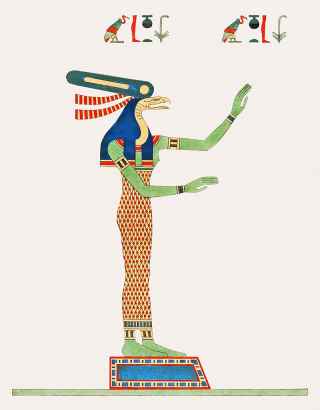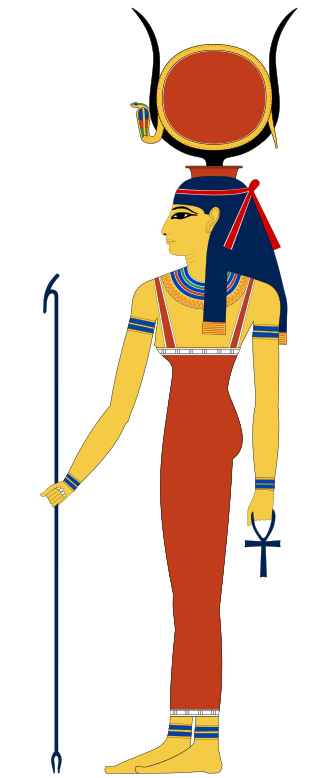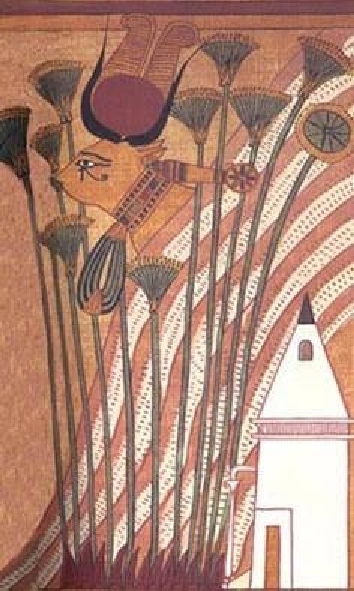NUMMO IN ANCIENT EGYPT
Nov. 15, 2022

WadjetThe Rose 2022 v. p. 117 (by Léon-Jean-Joseph Dubois from Pantheon Egyptien)
The uraeus was a symbol that originated with the Egyptian goddess, Wadjet, who was known as the green one. She was one of the earliest Egyptian deities and was often depicted as a cobra.
The alien Nummo were also green and were referred to as serpents. The Nummo also had gizzards like birds and Wadjet was often depicted with wings. She was associated with the Egyptian goddess Nekhbet, a vulture. The Nummo were considered dual or twins, and together Nekhbet and Wadjet were known as the "two ladies", representing the union of Upper and Lower Egypt.The Nummo 2018 v. p. 313

Hathor's Uraeus by Jeff DahlBy Jeff Dahl Own work, CC BY-SA 4.0, https://commons.wikimedia.org/w/ index.php?curid=3288609
The uraeus, which was depicted as an Egyptian cobra, asp, serpent or snake, signified divine authority. It often appeared on the headdress of Egyptian deities together with the sun disk. This is a sketch of the Egyptian goddess Hathor, from the tomb of Nefertari, depicting the uraeus and red sun disk.https://commons.wikimedia.org/wiki/ Category:Tomb_of_Nefertari The Dogon believed that red giant suns, which symbolized the Nummo, were pregnant suns. In astrophysics large red giant suns explode as supernovae to give birth to new stars and planets.Shannon Dorey, The Rose 2022 v. p. 8
In some instances, this image is also associated with the Egyptian goddess Isis. Both goddesses were depicted as cows, another symbol of the Nummo in the Dogon religion. In the Dogon language, the sun's name, nay, had the same etymology as mother, na, and cow, nã.The Rose p. 120

Hathor as Cow with Red Sun DiskThe Rose 2022 v. p. 120
This picture of Hathor from the Papyrus of Ani depicts Hathor as a cow with the red sun disk between her horns. As a symbol of a red giant star, the Nummo were depicted using a red, round calabash and were described as glistening and glowing in a ball of red light. The Dogon people described the red calabash as prefiguring "the 'matrix', where the world was formed."Shannon Dorey, The Rose 2022 v., p. 21
Because of this red giant star association, the Nummo were considered the mothers of humanity, the Earth, and the Milky Way Galaxy.Shannon Dorey, The Rose p. 20 The picture of Hathor shows a trail of stars and white lines, which I believe are being associated with the Milky Way.Shannon Dorey, The Rose 2022 v. p. 120
One Egyptian interpretation of the Milky Way was that it was the primal snake, Wadjet, as an aspect of the great mother goddess. The Going Forth of Wadjet was celebrated on December 25 with chants and songs. In The Nummo I associate her with the Dogon Mistress (Master) of Speech, an androgynous Christ figure, who was sacrificed to regenerate humanity.Shannon Dorey, The Nummo 2018 v. p. 314
The Mistress (Master) of Speech was the one who brought forth the "Word" and Hathor is shown with papyrus plants, a symbol associated with the "Word" in Egyptian culture. In the Dogon religion, the "Word" was a symbol of both DNA and all matter ejected from a red giant star.Shannon Dorey, The Rose 2022 v. p. 120
The Egyptian goddess Neith was considered an earlier form of the goddess Isis, and she also has Nummo-like characteristics. In quoting the coronation speech of Nectanebo III, the last native Pharaoh of Egypt, Margaret Murray reported that the reason the temple of Neith had been so endowed was because "Neith was the mistress of the ocean, and it was she who bestowed its bounty." The alien Nummo and the first Nummo/human offspring, of whom the Master (Mistress) of Speech was one, were amphibians but spent most of their time in water.Shannon Dorey, The Master (Mistress) of Speech, pp. 51-52
According to Kenneth McLeish, Neith was identified with weaving. He speculated that this aspect derived from the ideogram of her name, Neit, which looks like a shuttle. In the Dogon religion, weaving was identified with the androgynous and immortal Master (Mistress) of Speech, who had the perfect combination of human and Nummo DNA. She had a fish or serpent-like tail like the alien Nummo but had a human upper body.Shannon Dorey, The Master (Mistress) of Speech pp.50-51
Weaving was a metaphor for the Master (Mistress) of Speech's DNA being woven into the genetic fabric of humanity. Neith's connection to the shuttle may thus relate her to this Dogon figure, who was the saviour of humanity.
Katherine Griffis-Greenberg writes that Neith was an androgynous being often referred to in Egyptian texts as the "eldest," the "first" deity, and associated with the "cow of heaven." She quotes Ludwig Keimer, who suggests that the "shield" of Neith was the hindquarters of the beetle particular to Neith, the Agrypnus notodonta LATR, or "click beetle." Griffis-Greenberg also quotes Hollis, who pointed out that the self-generating qualities of the click beetle were the reason for its association with Neith.
The alien Nummo and the Master (Mistress) of Speech were self-fertilizing hermaphrodites, making this association of Neith to the click beetle relevant.Shannon Dorey, The Master (Mistress) of Speech pp.50-51
For more information on the Dogon religion refer to my books, The Master (Mistress) of Speech, The Nummo, Day of the Fish and The Rose.